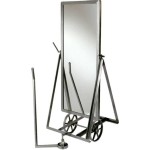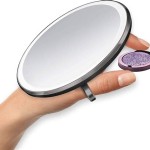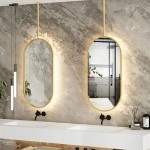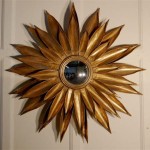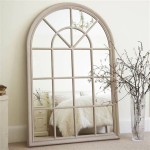How Tall Should a Leaner Mirror Be?
A leaner mirror, also known as a cheval mirror or floor mirror, offers a full-length reflection, making it an essential item for checking one's appearance. Selecting the correct height is crucial for its functionality. This article explores the factors influencing the ideal leaner mirror height, providing practical guidance for making an informed purchase.
The primary function of a leaner mirror is to provide a complete view of one's outfit. Therefore, the mirror's height should be sufficient to reflect the entire body from head to toe, with some additional space above and below for visual comfort. A mirror that cuts off the head or feet negates its purpose.
A common misconception is that taller individuals require taller mirrors. While height is a factor, it's not the sole determinant. The crucial element is the distance between the top of the head and the eyes. This distance dictates the minimum height required at the top of the mirror. Similarly, the distance from the eyes to the feet determines the minimum height needed at the bottom of the mirror.
To understand this concept, consider an individual looking into a mirror. The line of sight from the eyes to the top of the head and the line of sight from the eyes to the feet create angles that reflect off the mirror. The mirror needs to be tall enough to intersect these lines of sight and reflect the entire body.
Generally, a mirror height of around 60 to 65 inches (152 to 165 cm) often suffices for most individuals. This height accommodates the average human height and allows for a comfortable view. However, for taller individuals or those with specific needs, a taller mirror might be necessary.
Beyond individual height, the placement of the mirror also plays a role in determining the optimal height. If the mirror is placed on a raised surface, like a platform or thick rug, a shorter mirror might suffice. Conversely, if placed on a lower surface, a taller mirror might be required.
The angle of the leaner mirror also influences the required height. Leaner mirrors are designed to be tilted slightly backward, which affects the reflection. A steeper angle requires a taller mirror to capture the full reflection. A shallower angle might make do with a slightly shorter mirror, but can sometimes distort the reflection.
The ceiling height of the room should also be considered. While a taller mirror might seem desirable, it becomes impractical if it's too tall for the room. Measure the ceiling height beforehand to ensure the chosen mirror fits comfortably within the space.
When selecting a leaner mirror, physically testing it is highly recommended. Stand before the mirror and assess if it provides a complete and comfortable view. Pay attention to whether the reflection cuts off any part of the body. This practical test provides the most accurate assessment of suitability.
Several retailers offer leaner mirrors in various heights and styles. Explore different options to find one that meets specific requirements and complements the room's aesthetic. Consider adjustable leaner mirrors, which provide flexibility in adjusting the angle and effectively altering the reflective height.
Beyond height, other factors contribute to the overall functionality and aesthetic appeal of a leaner mirror. The width of the mirror should be sufficient to provide a comfortable view, especially when viewing the entire outfit. Frame style and material contribute to the overall aesthetic and should complement the room's decor.
The mirror's base should be sturdy and stable to prevent tipping. A wobbly base can be hazardous and compromise the mirror's functionality. Check the base materials and construction for durability and stability.
The quality of the mirror itself is paramount. Look for mirrors with clear, undistorted reflections. Avoid mirrors with ripples or imperfections that can distort the image. High-quality mirrors provide a true reflection and enhance the overall viewing experience.
The weight of the mirror is also a practical consideration. Heavier mirrors are generally more stable but can be difficult to move. Consider the weight in relation to the intended location and the frequency of moving the mirror.
In summary, selecting the appropriate height for a leaner mirror involves considering individual height, mirror placement, angle, ceiling height, and personal preference. A practical test in front of the mirror is invaluable in making the final decision. Considering these factors ensures a functional and aesthetically pleasing addition to any space.

How To Build Large Floor Leaner Mirror Sawdust 2 Stitches

Things To Consider When A Floor Mirror

Leaning Pictures And Mirrors The Easy Alternative To Hanging Art

Build A Beautiful Leaning Floor Mirror Designed Decor

Leaner Mirrors Best Floor For Your Space 2024

Leaner Mirrors Best Floor For Your Space 2024

Oversized Full Length Leaner Mirror Frameless
:max_bytes(150000):strip_icc()/MartinsenFullLengthMirror-05600e23ca9e42e1946dbae33ad729af.jpg?strip=all)
The 11 Best Floor Mirrors Of 2024

Extra Large Ornate White Wall Floor Leaner Full Length Mirror 100cm X 200cm Windsor Browne
Ovie Leaner Mirror Freedom

